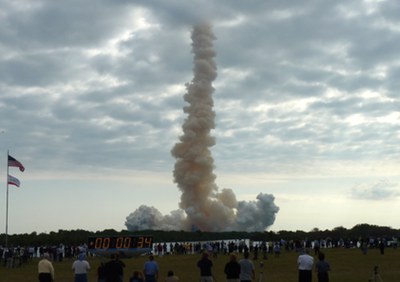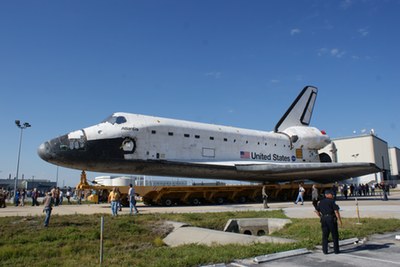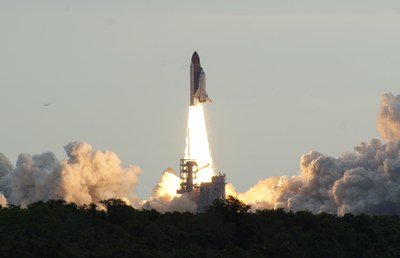The disappearing shuttleby Jeff Foust
|
| “You can see we don’t have any flight rules or launch commit criteria that state how long you can see the launch before it goes out of sight,” Moses quipped. |
That cloud layer—an isolated band that just happened to be over KSC at the time of launch—was one of the few concerns in the final hours of the countdown. Two and a half weeks earlier, NASA scrubbed Endeavour’s previous launch attempt when heaters in one of the orbiter’s three auxiliary power units (APUs) failed to turn on after the external tank received its load of liquid hydrogen and oxygen (see “A muddled future”, The Space Review, May 2, 2011). That led to extensive work to replace a power switching box and reroute some wiring. This time, everything worked as planned.
“I would characterize the countdown today as very normal for us,” shuttle launch director Mike Leinbach said in a post-launch press conference. There were a few minor problems, he said, such as a chipped tile near the crew hatch discovered during the closeout process after the astronauts had boarded. Technicians quickly repaired the damage and kept the launch on track. Mission managers also said they had a slight pressure issue with one of the fuel tanks in the orbital maneuvering system (OMS) pod, similar to the previous launch attempt, but concluded that they were not close to the pressure limits for the tank in question and let the launch move ahead.
 Just over half a minute after liftoff, all that’s visible is the shuttle’s plume extending from the pad to the clouds. (credit: J. Foust) |
The clouds, though, provided the greatest concern, at least to the several hundred thousand who gathered along the Space Coast to see the launch. Shuttle officials, though, there was never any significant threat posed by the clouds to the launch. “The weather was actually never no-go, and never forecast no-go, and I don’t think ever observed no-go,” Mike Moses, head of the mission management team, at the post-launch briefing. “This was not a close one on the weather. It was well within limits.”
Nonetheless, they acknowledged that the clouds diminished the visual impact of the launch for observers. “You can see we don’t have any flight rules or launch commit criteria that state how long you can see the launch before it goes out of sight,” Moses quipped.
“This was one of the quickest disappearances of the shuttle that I’ve experienced,” Leinbach said. “Since the clouds were so low this time, I can almost guarantee that you’ll see Atlantis longer on STS-135.”
The disappearance of Endeavour through the cloud bank was a reminder that the shuttle program itself will soon disappear: the launch of Atlantis on mission STS-135—now scheduled for July 8, NASA announced Friday—will be the final shuttle mission. Preparations for the launch are well underway, including the rollover of Atlantis to the Vehicle Assembly Building just 24 hours after Endeavour’s launch.
Despite the impending end of the program, NASA officials are trying to keep shuttle operations to their normal routine. “I’ve really challenged the team and challenged all of us to treat each one of these [final] missions, as much as we can, just like a regular mission,” said William Gerstenmaier, the NASA associate administrator for space operations. “I want it to feel just like this isn’t the last mission, but one of many missions going forward.”
| “I want it to feel just like this isn’t the last mission, but one of many missions going forward,” said Gerstenmaier. |
That challenge, though, will become increasingly difficult in the next month and a half. The week before the launch United Space Alliance, the contractor that handles shuttle operations, issued what are known as WARN (Worker Adjustment and Retraining Notification) notices to about half its current workforce, providing them with at least a 60-day warning of planned layoffs in July and August. While the notices had been expected for months, they help make what for years had been a vague notion about the end of the shuttle program into something very—and for many shuttle workers, terrifyingly—concrete.
 One day after the launch of Endeavour, Atlantis rolled over to the Vehicle Assembly Building to continue preparations for its, and the shuttle program’s, final flight. (credit: J. Foust) |
For some at KSC, Monday’s launch was their final launch: Leinbach notes that some people work exclusively with one orbiter. “This was their only final launch,” he said, unlikely those also involved with the final launches of Discovery and Atlantis. “Those folks are looking back on the history of Endeavour with fondness and probably a few tears today. But that’s okay, because they know they did the best job that they could, and Endeavour’s safely on orbit, so they did a great job.”
“One by one, each team is going to have their final flight,” he added. In less than two months, if NASA maintains its current schedule, all of those teams and other workers will have seen had their final flight. And with it the shuttle program, which has embodied NASA’s human spaceflight effort for over three decades, will also disappear—not as suddenly as Endeavour did during Monday’s launch, but just as certainly.
